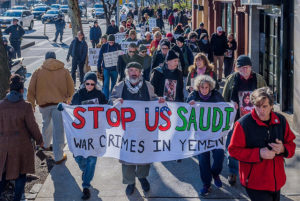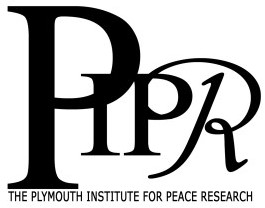A Story of Two Blockades: New York City and Yemen
By Brian Terrell
15 December, 2017

March photo by Joanne Kennedy
On December 11, in response to the growing humanitarian crisis in Yemen, more than 50 concerned people including representatives of various peace, justice and human rights organizations and communities, gathered in New York City’s Ralph Bunche Park, across First Avenue from the United Nations. Our message, which was communicated on signs and banners and by speakers addressing the rally, was simple and direct: end the war crimes being committed by the military of the United States along with Saudi Arabia and its coalition partners abetted by the US and end the blockade of Yemeni ports.
For more than two years, Saudi/US bombing has targeted civilian infrastructure: Hospitals, schools, factories, markets, funerals, sea ports, electrical power stations and water treatment facilities. US drones strikes and incursions by US Special Forces into Yemen have killed civilians as well. Armed conflict has directly taken the lives of some 12,000 people, but that tragic number is greatly exceeded by the number of those who are dying from a combination of malnutrition and otherwise easily preventable ailments and diseases like respiratory infections, measles, and cholera, including more than 1,000 children each week. 20 million of Yemen’s population of 28 million people are food insecure and few have access to clean drinking water. More than half of the hospitals in the country are not functioning.
Early in November, the already onerous blockade of Yemen’s ports was made practically total, prompting the United Nations Under-Secretary for Humanitarian Affairs to warn that, unless the blockade of Yemen was fully lifted, “… there will be a famine in Yemen… It will be the largest famine the world has seen for many decades, with millions of victims.”
On November 27, limited exceptions to the blockade were made for humanitarian aid shipments alone. The resulting tightly controlled deliveries have been decried as an empty and vastly insufficient gesture by humanitarian aid groups, who are calling for the ports to be opened to all humanitarian and commercial shipments. Under this pressure, President Trump issued a very brief statement calling upon the Saudis to “completely allow food, fuel, water and medicine to reach the Yemeni people who desperately need it.” Trump’s uncharacteristically polite request was not backed by anything much at all, much less by a freezing of US arms sales to the Saudis, nor did it address the practice of the US Air Force refueling Saudi fighter jets in mid-air or the US’ own drone strikes in Yemen.
Clearly, the times demand that more be done to counter this dire threat and some voices are being raised. Along with robust diplomatic efforts, there are legislative attempts to curtail arms sales to the Saudis. There have also been fasts, vigils and protests such as occurred in New York and other cities on December 11.
After speeches, songs and a powerful minute of silence, the rally moved up First Avenue to both the US and the Saudi Permanent Missions to the United Nations, led by banner reading “STOP US-SAUDI WAR CRIMES” and “LIFT THE BLOCKADE”, followed closely by officers of the New York City Police Department. Some of us felt compelled by conscience to stand in the doorway of the US Mission and after a short time, we were arrested for violating the “obstructing vehicular or pedestrian traffic” provision of the New York Penal Law regarding disorderly conduct. 15 of us, carrying photos of Yemeni child victims, were taken into custody and transported to the cells of the 7th Precinct on the city’s Lower East Side.
I could not help but wonder as we were handcuffed and loaded into vans, how those police officers could listen so impassively to the denunciations of crimes against humanity being committed and to the disclosures of a blockade that threatens the lives of millions, orchestrated from the buildings we stood before. How could these officers, then, after hearing our pleas and the stories of starving children without reaction, move so decisively to remove our nonviolent obstruction to the perpetrators of those crimes? Did they not wonder if they were arresting the wrong people?
The blockade of Yemen is an atrocious crime of the highest category, a violation of the United Nations Charter and the Universal Declaration of Human Rights and other international pacts. The US participation in the war on Yemen is a violation of the war powers provisions of the United States Constitution, at the very least. The imposition of our modest “blockade” of the United States Permanent Mission to the United Nations, in contrast, threatened no one. No one got sick or died because we stood in that doorway. In New York State, disorderly conduct is a violation, not even considered a crime at all. Still, the NYPD choose to ignore murder committed on its beat and to expend its prodigious resources to arrest and to prosecute law abiding citizens who demand an end to the crimes against Yemen.
Our protest began in Ralph Bunche Park, named after one of the founders of the United Nations and the first black American to receive the Nobel Peace Prize in 1950. Carved into the stone pavement there are these words from Mr. Bunche that speak to the present crisis in Yemen and to the many conflicts in the world today: “Peace, to have meaning for many who have known only suffering in both peace and war, must be translated into bread or rice, shelter, health, and education, as well as freedom and human dignity – a steadily better life. If peace is to be secure, long-suffering and long-starved, forgotten peoples of the world, the underprivileged and the undernourished, must begin to realize without delay the promise of a new day and a new life.”

